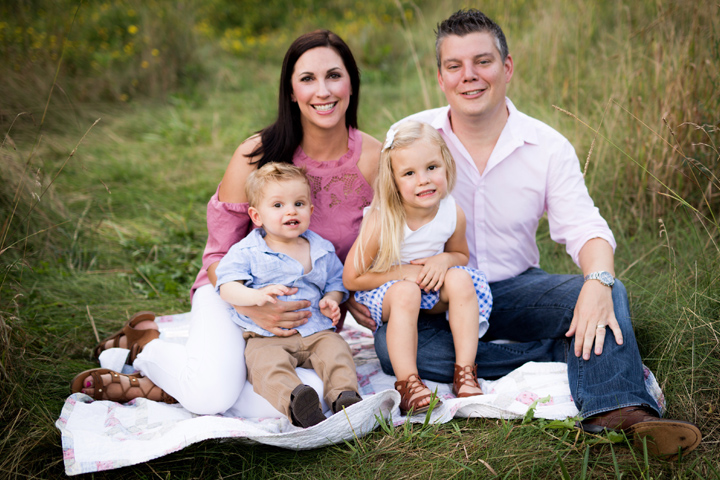Facing Pancreatic Cancer and Making the Most of Borrowed Time

- Despite months of pain, tumor hard to find because of location
- Tumor profiling finds a mutation
- Treatment with FOLFIRINOX, and then FOLFOX
In January 2017, I began to have slight right upper quadrant abdominal pain. I was just about to turn 38.
It was the same week my son was born and two weeks prior to taking my oral boards for my board certification as an oral surgeon, the culmination of 15 years of higher education and two years of board preparation. I thought the pain was from stress or an ulcer. I began the appropriate workup with a gastroenterologist, including medication and an endoscopic ultrasound, but nothing was found. The pain increased over time and by April, the pain had spread from my right to my left upper abdomen and radiated through to my back.
The pain was severe enough that I began to have insomnia, sometimes going up to five days without sleep or food despite continuous use of multiple sedatives. When I was able to fall asleep, often the pain would wake me up. Unfortunately, I have numerous allergies, including allergies to ibuprofen, acetaminophen, and aspirin. Whenever a doctor hears those three allergies in a patient who reports pain, especially in a patient with no diagnosis, they think “drug seeker.” This made it near impossible to acquire any form of pain control. Additionally, in my line of work I provide general anesthesia to my patients while performing surgery, it would have been irresponsible and downright dangerous to work while on pain medications. Thus, I dealt with the pain as best I could.
During this time, I underwent numerous tests and saw many different doctors near my home of Fairfax, Virginia. Besides the diagnostic testing for ulcers and a colonoscopy at the gastroenterologist, I saw my PCP, an infectious disease specialist, endocrinologist/immunologist, general surgeon, neurologist, cardiologist, pain specialist, and had visits to the emergency department. I even had my gall bladder removed in June. I was on all kinds of medications, I changed my diet, but nothing relieved the pain.
I began to have loss of appetite and weight loss, losing a total of 70 pounds by the time of diagnosis. By the time of diagnosis, I was frail, with some degree of cognitive impairment, nearly wheelchair-bound, with what is probably best described as a failure to thrive.
Finally, a Diagnosis: Pancreatic Cancer
After researching online daily my wife found a doctor at Johns Hopkins talking about a rare gall bladder problem that could cause the kind of pain I was in. We drove to Baltimore, and met with Dr. Anthony Nicholas Kalloo, an expert in Sphincter of Oddi dysfunction (now in Brooklyn, New York). He did not think that was the problem, but he assured me he would figure it out. I had an abdominal CT the next day. My wife and I stopped for lunch before leaving Hopkins and got a call from Dr. Kalloo to come back. He saw a mass on my scan, which he thought was lymphoma, so he scheduled me for a biopsy the next morning. A week later we got the results: pancreatic adenocarcinoma.
It took over seven months of testing and doctors’ appointments to find my tumor. Despite all of these tests, my cancer did not show up on any imaging until nearly two months after I had my gall bladder removed, due to its location. The tumor originated on the outer edge of my pancreas and grew into the fatty soft tissue behind it where it grew to involve some of the nerves in the area. Diffuse tumors in fatty tissue are difficult to see on imaging. This is why my pain started prior to the cancer being detectable radiographically. Once the tumor was found, tumor profiling and a genetic workup were done on the biopsy sample.
The cancer was stage IV. The tumor was growing off the head of the pancreas, into the abdominal cavity behind the peritoneum, with little to no actual tumor present within the pancreas. The tumor involved the celiac trunk, abdominal aorta, superior mesenteric artery, and bilateral renal arteries. There was metastatic disease present from Virchow’s lymph node in my neck to mesenteric and retroperitoneal lymph nodes, with small liver metastases as well.
Ultimately, I had a “million-dollar workup” prior to diagnosis. My wife and I are both medical professionals with a fair bit of knowledge about these sorts of things, more means than most, and many friends in the industry. I was fortunate enough to have the resources to undergo diagnostic measures that would not be available to most.
Getting Treatment
The genetic testing showed that I have an ATM mutation, and it is thought that tumors with an ATM mutation will also be susceptible to treatments that are effective for BRCA as well, like platinum-based drugs. I started chemotherapy with FOLFIRINOX, but I did not tolerate it well, suffering from extreme fatigue and diarrhea, so I was switched to FOLFOX. A celiac plexus block has eliminated the pain.
My side effects are fairly typical of the pancreatic cancer patient, namely fatigue, diarrhea, neuropathy, nausea, depression, insomnia, etc. I have tolerated them well enough with medication. I take a lot of other drugs to manage my symptoms, including dexamethasone, loperamide, diphenoxylate-atropine, duloxetine, budesonide, lidocaine, prochlorperazine, metoclopramide, ondansetron.
I have lived longer than originally predicted and am glad to be here for my wife and my two young children. We moved back to our hometown of Columbus, Ohio, for the family support. I see Dr. Jeffrey VanDeusen (formerly at The Ohio State University), but I still keep in touch with Dr. Valerie Lee, my oncologist at Johns Hopkins, and keep my general surgeon there, Dr. Matt Weiss, (now at Northwell Health in New York) apprised of my situation.
After a long battle with stage IV pancreatic cancer, Justin passed away. We offer our deep sympathy to his family.






